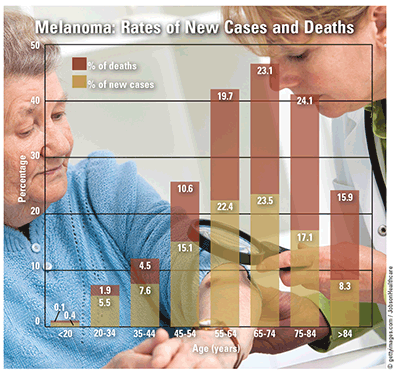US Pharm. 2018;43(6):12.
Melanoma is the least common type of skin cancer, but it is the most common skin cancer in persons aged 15 to 19 years (7%). In 2015, 1.2 million Americans had melanoma, and based on data for 2013 to 2015, 2.3% of Americans will be diagnosed with melanoma in their lifetime. The National Cancer Institute (NCI) Surveillance, Epidemiology, and End Results (SEER) Program estimates that, in 2018, melanoma will constitute 5.3% of all new cancer cases (91,270) and cause 9,320 deaths (1.5% of all cancer deaths).

Melanoma Development: The lifetime risk of developing melanoma has increased dramatically: The rate was 1:1,500 in 1935, 1:71 in 2004, and 1:50 in 2010. Melanoma accounts for 4% (77,000) of all newly diagnosed cancers each year. Whites develop melanoma five times more often than Hispanics and 20-fold more often than African Americans. Because diagnosis is more likely to occur at an early stage, 62.6% of new cases have a high probability of reaching the end of the treatment protocol, according to the NCI. According to the Annual Report to the Nation on the Status of Cancer, 1975-2014, annual melanoma diagnosis increased by an average of 2.3% and 0.9%, respectively, for men and women between 2009 and 2013.
Survival: Because melanoma is generally diagnosed at a very early stage, the 5-year survival rate exceeds 90%, according to a meta-analysis of SEER data. If the cancer has spread just to the lymph nodes by the time the melanoma is found, the 5-year survival rate drops to 60%. If the cancer spreads beyond the nodes to other parts of the body, however, the chance of 5-year survival drops significantly to less than 20%. Survival improved from 81.9% in 1975 to 93.2% in 2012 for all races combined, from 82% to 93.2% for whites and from 56.7% to 69.1% for blacks.
Incidence and Mortality: The number of new melanoma cases was 22.8 per 100,000 men and women per year. The number of deaths was 2.6 per 100,000 men and women per year. Melanoma is the most common cancer in adults aged 20 to 30 years and the leading cause of cancer death in women aged 25 to 30 years. From 2003 to 2012, the melanoma death rate remained unchanged. The yearly incidence rate of melanoma was 21% higher in men than in women (1.7% vs. 1.4%), but the difference in incidence was less (13%) in whites. The incidence remained stable in Hispanic men, but it decreased by 1.7% every year in Hispanic women.
To comment on this article, contact rdavidson@uspharmacist.com.






